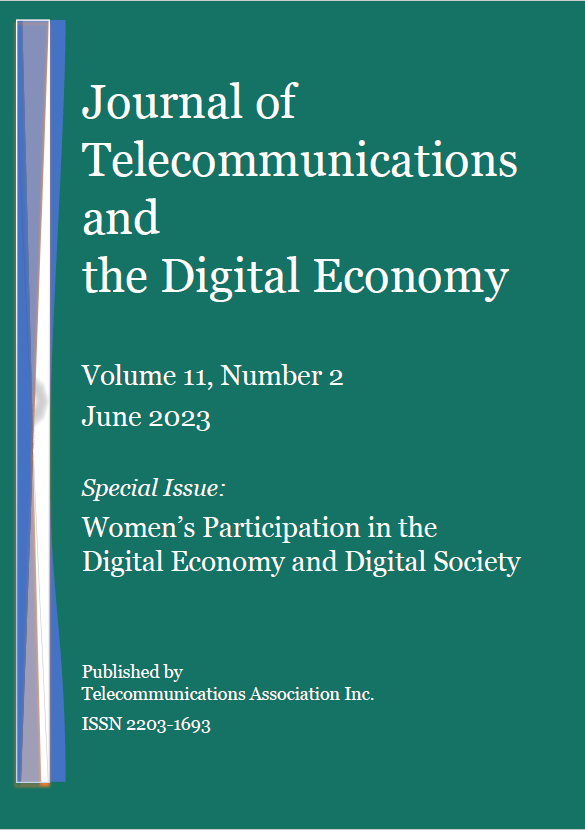Not a Toy for Boys Only Qualitative Insights into Promoting Women’s Participation in ICT in Croatia
Main Article Content
Keywords
women, digital gender gap, ICT, qualitative research
Abstract
Digital transformation contains the promise of social inclusion and progress, but current data reveal lingering social inequalities. This paper looks descriptively into relevant reports and data with the aim to identify the size of the digital gender gap, the main barriers to bridging it, the factors causing it, and reasons why we should strive to achieve gender balance in ICT. The paper also provides a short overview of some initiatives encouraging inclusion of women in ICT. The main objective of the paper is to provide qualitative insights into gender-related challenges in ICT companies in Croatia based on semi-structured snowball sampled key informant interviews with six women who are top professionals working in ICT companies in Croatia and who were initiators of various events to promote inclusion of women in ICT. The approach taken here assumes that qualitative research can address social problems in powerful and meaningful ways when focusing on practitioners rather than only policymakers. The results reveal positive trends with existing role models and more aware younger generations, but also many socio-cultural factors hindering full capacity development not only of women but even more so of men and the entire society.
References
Blau, F. D., & Kahn, L. M. (2017). ‘The gender wage gap: Extent, trends, and explanations. Journal of Economic Literature. 55(3), 789–865. http://dx.doi.org/10.1257/jel.20160995
Broadband Commission. (2013). Doubling Digital Opportunities: Enhancing the Inclusion of Women and Girls in the Information Society. Available from http://www.broadbandcommission.org/documents/working-groups/bb-doubling-digital-2013.pdf.
Brodman, J, & Berazneva, J. (2007). Transforming Opportunities for Women Entrepreneurs. Information Technologies and International Development, Special issue on Women’s Empowerment and the Information Society, 4(2), 3–10. http://dx.doi.org/10.1162/itid.2008.00003
Castells, M. (2000). The rise of the network society. Blackwell Publishers Ltd.
Croatian Bureau of Statistics. (2022). Women and Men in Croatia, 2022. [Internet]. Accessed 30 January 2023. Available from https://podaci.dzs.hr/media/04pff1do/women_and_man_2022.pdf.
Cruz-Jesus, F., Vicente, M. R., Bacao, F., & Oliveira, T. (2016). The education-related digital divide: an analysis for the EU-28. Computers in Human Behaviour, 56, 72–82. http://dx.doi.org/10.1016/j.chb.2015.11.027
Davaki, K. (2018). The underlying causes of the digital gender gap and possible solutions for enhanced digital inclusion of women and girls. European Parliament. [Internet]. Accessed 30 January 2023. Available from https://www.europarl.europa.eu/RegData/etudes/STUD/2018/604940/IPOL_STU(2018)604940_EN.pdf
Dehghan, H., & Rahiminezhad, V. (2010). ICT and gender digital divide in Iran. INTED2010 Proceedings: 2820–2824.
Dighe, A., & Reddi, U. (2015). Women’s Literacy and Information and Communication Technologies: Lessons that Experience has Taught us. International Women Online Journal of Distance Education, 4(2). Available from https://dergipark.org.tr/en/pub/intwojde/issue/8673/108540.
EIGE. (2016). Gender and Digital Agenda. Luxemburg: European Institute for Gender Equality, p. 3.
EIGE. (2019). Gender equality and youth: opportunities and risks of digitalisation – Main report. [Internet]. Accessed 30 January 2023. Available from https://eige.europa.eu/publications/gender-equality-and-youth-opportunities-and-risks-digitalisationder equality and youth: opportunities and risks of digitalisation | European Institute for Gender Equality (europa.eu).
European Commission. (2022). Croatia in the Digital Economy and Society Index. [Internet]. Accessed 30 January 2023. Available from https://digital-strategy.ec.europa.eu/en/policies/desi-croatia.
European Parliament. (2016). Report on Gender Equality and Empowering Women in the Digital Age. (2015/2007(INI) Brussels: European Parliament, p. 10.
Fallows, D. (2005). How Women and Men Use the Internet. Pew Internet & American Life Project. Available from https://www.pewresearch.org/internet/2005/12/28/how-women-and-men-use-the-internet/.
Faulkner, W. (2001). The technology question in feminism: A view from feminist technology studies. Women’s Studies International Forum, 24(1), 79–95.
Goldin, C. (2014). A grand gender convergence: Its last chapter. The American Economic Review, 104(4), 1091–1119. http://dx.doi.org/10.1257/aer.104.4.1091
Hafkin, N., & Huyer, S. (2007). Women and gender in ICT statistics and indicators for development. Information Technologies and International Development, 4(2), 25–41. http://dx.doi.org/10.1162/itid.2008.00006
Harcourt, W. (Ed.). (1999). Women@Internet. Palgrave Macmillan.
Heeks, R., Arun, S., & Morgan, S. (2004). Researching ICT-based enterprise for women in developing countries: a gender perspective. In Women's ICT-Based Enterprise for Development project. Institute for Development Policy and Management (IDPM), Manchester. Available from http://www.womenictenterprise.org/LivelihoodsResearch.doc
Hilbert, M. (2011). Digital gender divide or technologically empowered women in developing countries? A typical case of lies, damned lies, and statistics. Women's Studies International Forum, 34(6), 479–489. http://dx.doi.org/10.1016/j.wsif.2011.07.001
ITU. (2012). A Bright Future in ICT: Opportunities for a New Generation of Women. Geneva: International Telecommunications Union. Available at: https://www.itu.int/en/ITU-D/Digital-Inclusion/Women-and-Girls/Documents/ReportsModules/ITUBrightFutureforWomeninICT-English.pdf
Kelkar, G., & Nathan, D. (2002). Gender Relations and Technological Change in Asia. Current Sociology, 50(3), 427–441. http://dx.doi.org/10.1177/0011392102050003008
Lichtman, M. (2013). Qualitative research for the social sciences. Sage.
OECD. (2018). Bridging the digital gender divide. Include, upskill, innovate. Available at https://www.oecd.org/digital/bridging-the-digital-gender-divide.pdf
Scott, A. (2001). (In)Forming politics: Processes of feminist activism in the information age. Women's Studies International Forum, 24(3-4), 409–421.
Silverman, D. (2022). Doing qualitative research (6th edition). Sage.
UN. (2023). International Day of Women and Girls in Science, 11 February. Available at https://www.un.org/en/observances/women-and-girls-in-science-day
UNICEF. (2021). What we know about the gender digital divide for girls: A literature review. Available from https://www.unicef.org/eap/media/8311/file/What%20we%20know%20about%20the%20gender%20digital%20divide%20for%20girls:%20A%20literature%20review.pdf
Varank, I. (2007). Effectiveness of Quantitative Skills, Qualitative Skills, and Gender in Determining Computer Skills and Attitudes: A Causal Analysis. The Clearing House, 81(2), 71–80. http://dx.doi.org/10.3200/TCHS.81.2.71-80
Wajcman, J. (1991). Feminism confronts technology. Cambridge: Polity Press.
WDR (World Development Report). (2016). Digital Dividends. A World Bank Group Flagship Report. Available at https://www.worldbank.org/en/publication/wdr2016
World Internet Project. (2009). World Internet International Report 2009. USC Annenberg School Center for the Digital Future. Available from https://www.digitalcenter.org/wp-content/uploads/2013/02/WIP-report-2009-final.pdf






